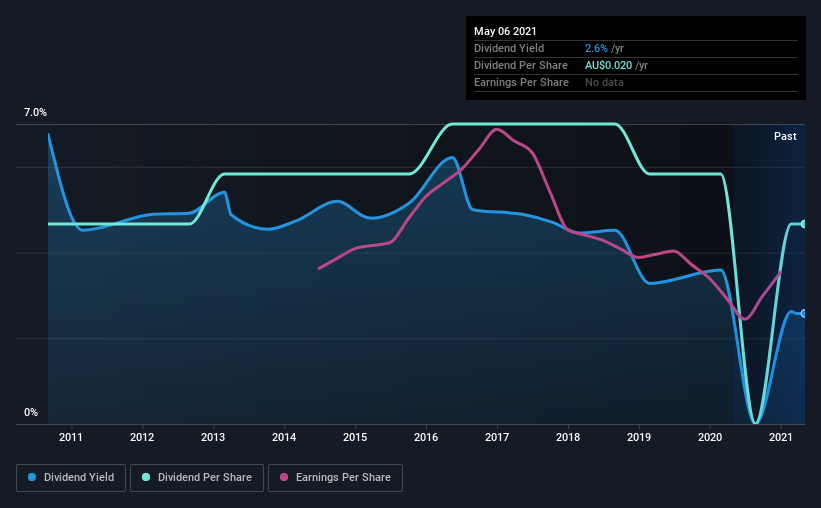Read This Before Considering United Overseas Australia Limited (ASX:UOS) For Its Upcoming AU$0.02 Dividend
Some investors rely on dividends for growing their wealth, and if you're one of those dividend sleuths, you might be intrigued to know that United Overseas Australia Limited (ASX:UOS) is about to go ex-dividend in just 4 days. Ex-dividend means that investors that purchase the stock on or after the 11th of May will not receive this dividend, which will be paid on the 4th of June.
United Overseas Australia's next dividend payment will be AU$0.02 per share, on the back of last year when the company paid a total of AU$0.02 to shareholders. Looking at the last 12 months of distributions, United Overseas Australia has a trailing yield of approximately 2.6% on its current stock price of A$0.775. If you buy this business for its dividend, you should have an idea of whether United Overseas Australia's dividend is reliable and sustainable. As a result, readers should always check whether United Overseas Australia has been able to grow its dividends, or if the dividend might be cut.
Check out our latest analysis for United Overseas Australia
Dividends are typically paid from company earnings. If a company pays more in dividends than it earned in profit, then the dividend could be unsustainable. That's why it's good to see United Overseas Australia paying out a modest 30% of its earnings. That said, even highly profitable companies sometimes might not generate enough cash to pay the dividend, which is why we should always check if the dividend is covered by cash flow. The good news is it paid out just 17% of its free cash flow in the last year.
It's encouraging to see that the dividend is covered by both profit and cash flow. This generally suggests the dividend is sustainable, as long as earnings don't drop precipitously.
Click here to see how much of its profit United Overseas Australia paid out over the last 12 months.
Have Earnings And Dividends Been Growing?
Companies with falling earnings are riskier for dividend shareholders. Investors love dividends, so if earnings fall and the dividend is reduced, expect a stock to be sold off heavily at the same time. United Overseas Australia's earnings per share have fallen at approximately 7.8% a year over the previous five years. Such a sharp decline casts doubt on the future sustainability of the dividend.
Another key way to measure a company's dividend prospects is by measuring its historical rate of dividend growth. United Overseas Australia's dividend payments are broadly unchanged compared to where they were 10 years ago. If a company's dividend stays flat while earnings are in decline, this is typically a sign that it is paying out a larger percentage of its earnings. This can become unsustainable if earnings fall far enough.
Final Takeaway
From a dividend perspective, should investors buy or avoid United Overseas Australia? Earnings per share are down meaningfully, although at least the company is paying out a low and conservative percentage of both its earnings and cash flow. It's definitely not great to see earnings falling, but at least there may be some buffer before the dividend needs to be cut. In summary, it's hard to get excited about United Overseas Australia from a dividend perspective.
So while United Overseas Australia looks good from a dividend perspective, it's always worthwhile being up to date with the risks involved in this stock. Our analysis shows 3 warning signs for United Overseas Australia that we strongly recommend you have a look at before investing in the company.
A common investment mistake is buying the first interesting stock you see. Here you can find a list of promising dividend stocks with a greater than 2% yield and an upcoming dividend.
This article by Simply Wall St is general in nature. It does not constitute a recommendation to buy or sell any stock, and does not take account of your objectives, or your financial situation. We aim to bring you long-term focused analysis driven by fundamental data. Note that our analysis may not factor in the latest price-sensitive company announcements or qualitative material. Simply Wall St has no position in any stocks mentioned.
Have feedback on this article? Concerned about the content? Get in touch with us directly. Alternatively, email editorial-team (at) simplywallst.com.

